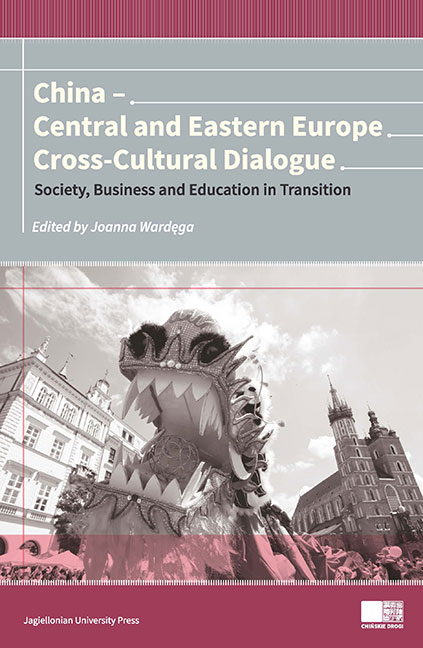Book contents
- Frontmatter
- Contents
- Foreword
- PART I Society and Culture in Transition
- PART TWO Economy and Markets in Transition
- PART THREE Education in Transition
- Opening the Two-Way Fast Lane for China-CEE Cultural Exchange by Equally Valuing the International Promotion of the Chinese Language and the CEE Languages Teaching
- A Contrastive Analysis of Traditional Chinese and Western Teaching Styles – A Case Study
- How Does Learning Style and Teaching Style Jointly Relate to Cultural Intelligence? A Study of Chinese Overseas Students
- Preparation of University Students from Western Cultures for Cooperation with China: Reasons and Methods
- Facing the Challenges of Teaching Chinese through Confucius Classrooms in Slovenian Schools: Current Situation and Prospects
- The Role of the Confucius Institute at Ss. Cyril and Methodius University in Skopje in Promoting the Chinese language, Culture and Business in the Republic of Macedonia
- Education in Transition of China-Based Jesuits from the Austrian Province
- Link in the History: The Development of the Research on Avguštin Hallerstein and its Contemporary Meaning
- Contributors
How Does Learning Style and Teaching Style Jointly Relate to Cultural Intelligence? A Study of Chinese Overseas Students
from PART THREE - Education in Transition
Published online by Cambridge University Press: 22 December 2017
- Frontmatter
- Contents
- Foreword
- PART I Society and Culture in Transition
- PART TWO Economy and Markets in Transition
- PART THREE Education in Transition
- Opening the Two-Way Fast Lane for China-CEE Cultural Exchange by Equally Valuing the International Promotion of the Chinese Language and the CEE Languages Teaching
- A Contrastive Analysis of Traditional Chinese and Western Teaching Styles – A Case Study
- How Does Learning Style and Teaching Style Jointly Relate to Cultural Intelligence? A Study of Chinese Overseas Students
- Preparation of University Students from Western Cultures for Cooperation with China: Reasons and Methods
- Facing the Challenges of Teaching Chinese through Confucius Classrooms in Slovenian Schools: Current Situation and Prospects
- The Role of the Confucius Institute at Ss. Cyril and Methodius University in Skopje in Promoting the Chinese language, Culture and Business in the Republic of Macedonia
- Education in Transition of China-Based Jesuits from the Austrian Province
- Link in the History: The Development of the Research on Avguštin Hallerstein and its Contemporary Meaning
- Contributors
Summary
According to a recent global education report, Chinese overseas students are the largest group among international students in most countries. As the US 2013 Open Doors report mentioned, “The growth of international students’ number is largely driven by students from China. The enrolments of Chinese student soar by 21 percent in total and reach almost 235,000 students, while those of other countries only take less than 5 percent of the total.” With more and more Chinese students going abroad, some inconspicuous cross-cultural problems emerge. Not only do these problems disturb the students’ families and the students themselves, but also pose some unnecessary trouble for host universities and culture in general. Recently, those problems have become much more serious due to the fact that most of overseas students who were born after 1980 under the Chinese “one-child policy” always assume self-central thinking style.
Nowadays, there are more and more training programs in China, offered by home universities, host universities, and even some special training institutions, aimed at improving students’ understanding of the new culture and helping them adapt to the new environment more easily and quickly. More and more literary sources are focused on setting up effective cross-cultural training courses to assist outsiders in adapting to the oversea environment more smoothly. But the nature of these training programs is that they have to cater to the needs of overseas students and allow for the cultural background of host universities and countries (Hodgetts & Luthans 2000; Hutchings 2005). Because that kind of training programs is generally intensive and only provides surface knowledge, there is only little improvement observed in students after taking that kind of training. The most important point to be taken is how to gain knowledge about a new culture rather than superficial content. Having the habit of self-educating is very important for students who stay aboard and adapt to a new social environment. And the increasing emphasis on the students learning style could promote students’ practical adaption, especially in the case of Chinese students, most of whom develop their basic knowledge through self-study in high school under high pressure from the National College Entrance Examination (NCEE), and they first gain their social knowledge in their college life, so, from the phenomenon noted above, we could infer that the importance of effective learning style has been neglected by cross-cultural practitioners.
- Type
- Chapter
- Information
- China - Central and Eastern Europe Cross-Cultural Dialogue Society, Business and Education in Transition , pp. 341 - 362Publisher: Jagiellonian University PressPrint publication year: 2016



